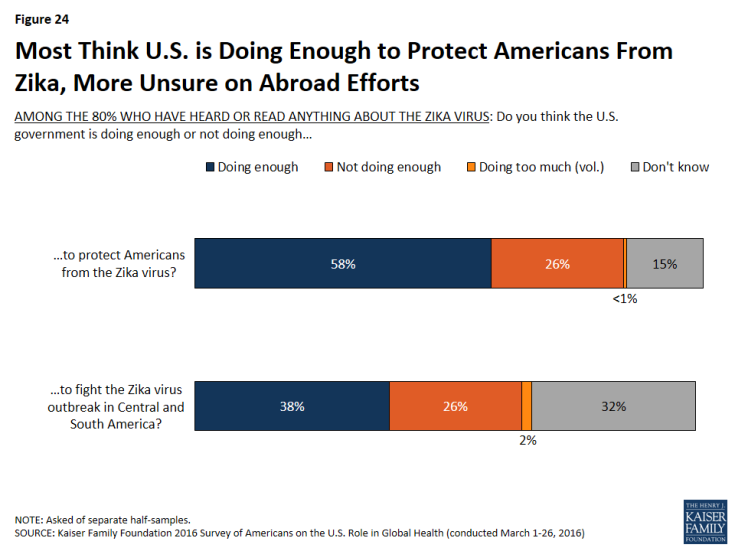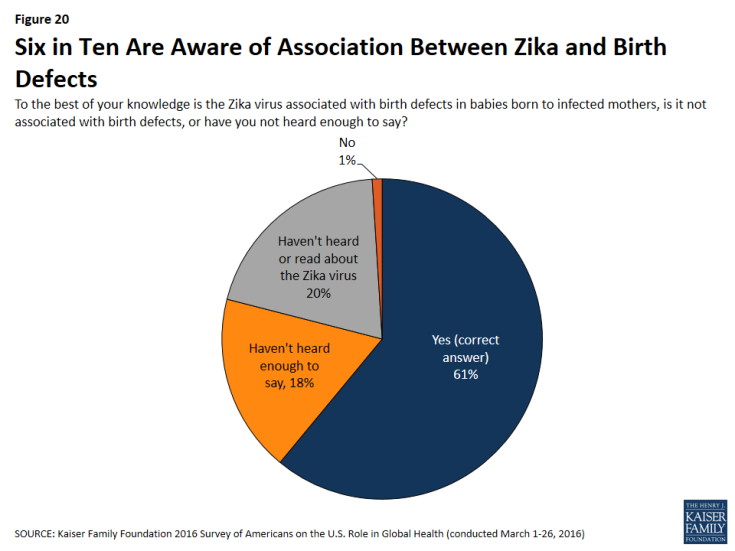2016 Survey of Americans on the U.S. Role in Global Health
Section 2: Views on the U.S. Role Improving the Lives of Women and Girls in Developing Countries
Many health issues in developing countries have a disproportionate impact on women and girls, and the most recent survey took an in-depth look at the public’s views on the U.S. role in improving women’s health, with a particular focus on the recent outbreak of the Zika virus in Central and South America. As noted above, nearly all Americans (90 percent) view promoting opportunities for women and girls as an important priority for U.S. engagement in foreign affairs, with over a third (36 percent) deeming it one of the top priorities.
The public also largely recognizes that most women in developing countries are disadvantaged compared with their male counterparts. Large majorities say that women in developing countries are worse off than men in their legal rights (81 percent), ability to get a good education (78 percent), likelihood of living in poverty (71 percent), and their ability to get the health care services they need (63 percent).
Interestingly, men and women provide similar responses, with majorities of both sexes saying that women are worse off. The only item in which women are more likely than men to say that women are worse off is the likelihood of living in poverty with 75 percent of women saying the women are worse off compared to 67 percent of men.
More than half (52 percent) of Americans think the U.S. government is not doing enough to improve the lives of women and girls in developing countries, while about one-third of Americans (32 percent) think the U.S. government is currently doing enough and 4 percent say the U.S. is either doing too much or shouldn’t be involved. A large majority of Democrats (68 percent) and a slim majority of independents (52 percent) say the U.S. government is not doing enough, while Republicans are more evenly split with 42 percent saying the U.S. government is doing enough and 36 percent saying it is not doing enough.

Figure 17: Half of the Public Says U.S. is Not Doing Enough to Improve Lives of Women in Developing Countries
The Zika Virus
One recent global health development that has a disproportionate impact on women in developing countries is the Zika virus outbreak. The mosquito-borne Zika virus, which has mostly affected South and Central American countries and has been associated with birth defects in babies born to infected mothers, was declared a global health emergency by the United Nations on February 1st.1 Eight in ten Americans say they have heard or read about the Zika virus, with 23 percent saying they have heard or read “a lot” and 32 percent saying they have heard “some.”
The majority of the American public is aware of the potential ways to spread the virus and potential effects of the virus. About three-quarters (73 percent) are aware that a person can become infected through a bite from an infected mosquito, more than half (53 percent) are aware that a person can become infected by having sex with someone who is infected, and 64 percent are aware that it does not appear to be spread through shaking hands with an infected person.
Six in ten Americans know about the connection between the Zika virus and birth defects in children born to infected mothers. This connection was confirmed by the CDC on April 13th, 2016.2
Given this link, concerns have been raised about women’s access to contraception in Zika-affected areas3. Three-fourths (76 percent) of Americans say that most women in developing countries do not have adequate access to birth control while just 12 percent believe these women have adequate access and another 12 percent are unsure. When asked specifically about developing countries affected by the Zika virus, results are somewhat similar. Most (65 percent) of those who have heard or read about the Zika virus say women in developing countries affected by the virus do not have adequate access to birth control, while 16 percent believe they do have adequate access and 18 percent are unsure.

Figure 21: Majority of Americans Think Women in Developing Countries Do Not Have Adequate Access to Birth Control
Women are somewhat more likely than men to know about the connection between the Zika virus and birth defects in babies born to infected mothers. Sixty-four percent of women report knowing about this connection compared to 57 percent of men. In addition, women are more likely than men to worry that they or someone in their family will be affected by the Zika virus and to worry that the U.S. will see a large number of cases of the Zika virus in the next 12 months. Nearly half of women (46 percent) are “very” or “somewhat” worried that the U.S. will see a large number of Zika cases, compared to 35 percent of men. Three in ten women (31 percent) are worried that they or someone in their family will be affected by the Zika virus, compared to 23 percent of men.
Despite this, fewer than one in ten Americans (9 percent) report they have changed their travel plans to avoid countries affected by Zika, including 12 percent of women of reproductive age (those between the ages of 18 and 49).
Attitudes Towards U.S. Efforts to Fight the Zika Virus
Among those who have heard or read anything about the Zika virus, a majority give mostly positive ratings to government efforts to combat Zika in the United States, though many are unsure about U.S. efforts in Central and South America. Six in ten (58 percent) say the U.S. is doing enough to protect Americans from the virus, while one in four (26 percent) say the U.S. is not doing enough and another 15 percent say they don’t know enough to say. Comparatively, four in ten (38 percent) say the U.S. is doing enough to fight the Zika virus in Central and South America, while 26 percent say the U.S. is not doing enough and almost a third (32 percent) say they don’t know enough to say. Two percent volunteer that the U.S. is doing too much in this area or should not be involved.

Figure 24: Most Think U.S. is Doing Enough to Protect Americans From Zika, More Unsure on Abroad Efforts
Attitudes are also split on whether the U.S. is doing enough to help women in developing countries who may be at risk for the Zika virus make family planning and preventive health decisions. One-third (34 percent) of Americans who have heard or read anything about Zika, say the U.S. government is not doing enough, which is roughly equal to the share who say it is doing enough (33 percent). Democrats are more likely to say the U.S. government is not doing enough (45 percent), compared to 33 percent of independents and 19 percent of Republicans.
| Table 4: U.S. Government Doing Enough to Help Women in Developing Countries At Risk for Zika | ||||
| Among those who have heard/read anything about Zika | ||||
| Do you think the U.S. government is doing enough or not doing enough to help women in Central and South America who may be at risk for the Zika virus make family planning and preventive health decisions? | Total | Democrats | Independents | Republicans |
| Doing enough | 33% | 27% | 31% | 43% |
| Not doing enough | 34 | 45 | 33 | 19 |
| Doing too much/Should not be involved (vol.) | 2 | <1 | 3 | 4 |
| Don’t know | 30 | 27 | 33 | 33 |
When asked whether the U.S. should or should not take several actions in response to the Zika virus, nine in ten of those who have heard or read anything about Zika say the U.S. should invest resources to prevent the spread of Zika in the U.S. More than eight in ten (83 percent) also say the U.S. should invest more money in research on Zika, while three-fourths want the U.S. to help women in Zika-affected countries access birth control (77 percent), and provide financial aid to Zika-affected countries (72 percent).








